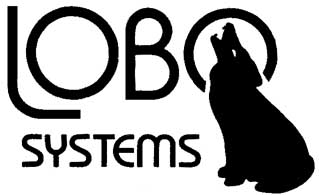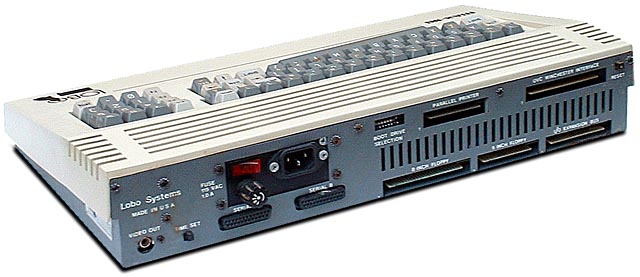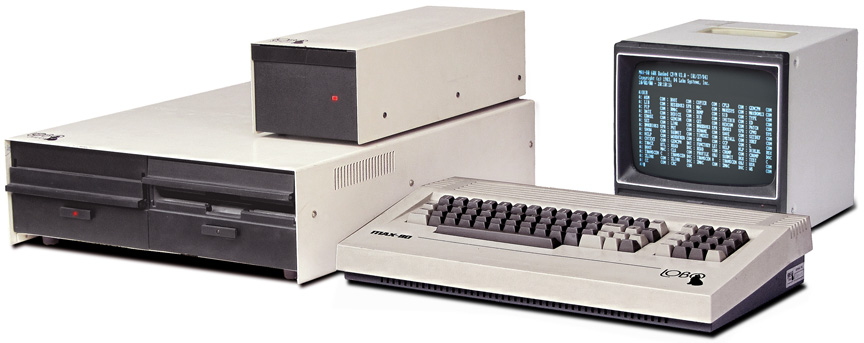
|




| Lobo Fact or Fiction? Information I've been told or I've seen on news groups - you decide! |
| Lobo was built in Santa Barbara. The story from Roger Billings, the person who started Lobo, was that he was the production manager for Polymorphic Computers. At some point, they started running into financial problems that prevented them from buying the parts they needed, and Roger started Lobo Drives buying the parts and selling them to Polymorphic. The name Lobo came about because of his pet wolf, Lobo. They started out with Apple drives and developed the Lobo Computer afterwards. |
|
The Lobo company started off peddling cheap refurb SA400s for use on TRS80. First bare drives, then with case and power supply.
Then they decided to make their own TRS80 expansion interface, and eventually entire computer.
When they built their expansion interface, they provided for use of 8" drives, and also for "double density". But they failed to realize that the WD 179x FDC that they used in order to have double density was incapable of writing certain address marks that RS had used with the 1771 FDC in the TRS80. Thus, their machine was incapable of writing disks readable by a stock TRS80 running TRS-DOS. That is why the Percom Doubler had a spare socket to plug in the 1771 to have BOTH FDCs present. So, they had to come up with their own system software. They bought out VTOS, which was Randy Cook's TRSDOS 3.0 and 4.0. Randy Cook had written TRS-DOS, but never finished getting it working; Radio Shack kicked him out and finished it as TRS-DOS 2.3. Then Randy wrote TRS-DOS 3.0 (never finished) and tried to market it as VTOS 3.0; he never finished it, and his publisher refused to pay him. Then Randy wrote VTOS 4.0 , published by Adventure International Scott Adams; he never finished it, and Adams refused to pay him. Lobo hired almost every TRS80 assembly language programmer, such as Roy Soltoff, and put them to work to finish the OS and write a manual. They got rid of Randy, because he could never finish ANY project. When done, they had Lobo-DOS 5.0. They started up a separate company ("Logical Systems, Inc.") to market it, and it became "LDOS 5.0". Later, after RS made the same mistake (model III), RS bought rights to sell LDOS, and it became TRS-DOS 6.0. And Randy Cook finally began to get royalties! |
| The Max had a SASI interface though it was not labeled as such. SASI - Shugart Associated Smallsystem Interface.
With minor changes this became the SCSI spec and the name was changed as the standards committee could not permit a commercial name to be part of the designation. |
|
CREATIVE COMPUTING VOL. 9, NO. 8 / AUGUST 1983 / PAGE 188
1983 National Computer Conference, May 16-19, Anaheim, California. David H. Ahl. Lobo Systems were showing their Max-80, a direct-sold computer with a hard-to-beat price of $945. The Max-80 uses a Z80B mpu at a 5MHz clock rate (that's 2-1/2 times faster than most Z80 machines). It has 128K, floppy and Winchester disk interfaces, two RS-232 ports, a Centronics port, built-in clock with battery backup, 24-line X 80-character display, and full keyboard with numeric keypad. A dual 5-1/4 double-density, double-sided disk drive (690K total) is priced at just $695. A 1.4Mb unit is priced at $895. In addition, the Max-80 comes with CP/M Plus, an enhanced version of CP/M 2.2. Also available for an extra $69 is LDOS which allows the unit to run most TRS-80 Model III software. All in all, I was most impressed with this system! Source:http://www.atarimagazines.com/creative/index/ |
|
DTACK GROUNDED #16 January 1983
We have just purchased a MAX-80 from Lobo (see BYTE, Dec '82, p.551). We ordered it with a 64K expansion. Ninety-five bucks. That's $570 per 384K or $1520 per megabyte. Just who is kidding whom, fellows? But do you know how Lobo is selling the MAX-80? Factory direct! And they expect you to pay in advance or else send a deposit and pay the balance COD! Gadzooks! Don't they know a company can't operate like that? |
|